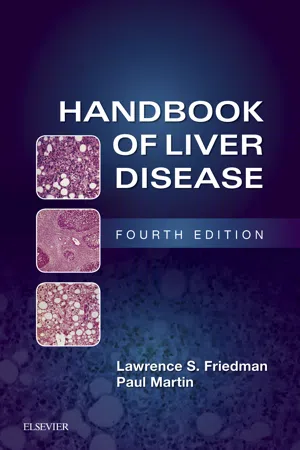
- 550 pages
- English
- ePUB (mobile friendly)
- Available on iOS & Android
Handbook of Liver Disease E-Book
About this book
Well-organized and vibrantly illustrated throughout, Handbook of Liver Disease is a comprehensive yet concise handbook providing authoritative guidance on key clinical issues in liver disease. The quick-reference outline format ensures that you'll find answers when you need them, and cover-to-cover updates keep you abreast of the recent rapid changes in the field. Written by leading international experts in hepatology, this reference is ideal for hepatologists, gastroenterologists, internists, family practitioners, trainees, and others who diagnose and manage patients with liver disorders.- Uses a highly templated outline format, key points in each chapter, alert symbols, and highlighted review points to provide a "just the facts" approach to daily clinical questions on liver disease.- Features expanded hepatitis chapters, including completely updated coverage of new, safe, and effective oral regimens for the treatment of hepatitis C.- Provides completely updated coverage of: alcoholic liver disease * autoimmune hepatitis * portal hypertension * primary biliary cholangitis * hepatic tumors * cirrhosis * nonalcoholic liver disease * liver transplantation * and more.- Includes the latest information on adolescents with liver disease moving into adult care.- Covers the revised criteria for prioritizing liver transplantation using the MELDNa score, new options for the treatment of hepatocellular carcinoma, and improved management of hepatorenal syndrome.
Frequently asked questions
- Essential is ideal for learners and professionals who enjoy exploring a wide range of subjects. Access the Essential Library with 800,000+ trusted titles and best-sellers across business, personal growth, and the humanities. Includes unlimited reading time and Standard Read Aloud voice.
- Complete: Perfect for advanced learners and researchers needing full, unrestricted access. Unlock 1.4M+ books across hundreds of subjects, including academic and specialized titles. The Complete Plan also includes advanced features like Premium Read Aloud and Research Assistant.
Please note we cannot support devices running on iOS 13 and Android 7 or earlier. Learn more about using the app.
Information
Assessment of Liver Function and Diagnostic Studies
Abstract
Keywords
Routine Liver Biochemical Tests
Serum Bilirubin
Table of contents
- Cover image
- Title page
- Table of Contents
- Copyright
- Dedication
- Contributors
- Preface
- Acknowledgments
- Special Tribute
- Foreword
- Chapter 1. Assessment of Liver Function and Diagnostic Studies
- Chapter 2. Acute Liver Failure
- Chapter 3. Hepatitis A and Hepatitis E
- Chapter 4. Hepatitis B and Hepatitis D
- Chapter 5. Hepatitis C
- Chapter 6. Hepatitis Caused by Other Viruses
- Chapter 7. Autoimmune Hepatitis
- Chapter 8. Alcoholic Liver Disease
- Chapter 9. Fatty Liver and Nonalcoholic Steatohepatitis
- Chapter 10. Drug-Induced and Toxic Liver Disease
- Chapter 11. Cirrhosis and Portal Hypertension
- Chapter 12. Portal Hypertension and Gastrointestinal Bleeding
- Chapter 13. Ascites and Spontaneous Bacterial Peritonitis
- Chapter 14. Hepatorenal Syndrome
- Chapter 15. Hepatic Encephalopathy
- Chapter 16. Primary Biliary Cholangitis
- Chapter 17. Primary Sclerosing Cholangitis
- Chapter 18. Hemochromatosis
- Chapter 19. Wilson Disease and Related Disorders
- Chapter 20. Alpha-1 Antitrypsin Deficiency and Other Metabolic Liver Diseases
- Chapter 21. Budd-Chiari Syndrome and Other Vascular Disorders
- Chapter 22. The Liver in Heart Failure
- Chapter 23. The Liver in Pregnancy
- Chapter 24. The Liver in Systemic Disease
- Chapter 25. Pediatric Liver Disease
- Chapter 26. Liver Disease in the Elderly
- Chapter 27. Hepatobiliary Complications of HIV
- Chapter 28. Granulomatous Liver Disease
- Chapter 29. Hepatic Tumors
- Chapter 30. Hepatic Abscesses and Cysts
- Chapter 31. Other Infections Involving the Liver
- Chapter 32. Surgery in the Patient With Liver Disease and Postoperative Jaundice
- Chapter 33. Liver Transplantation
- Chapter 34. Cholelithiasis and Cholecystitis
- Chapter 35. Diseases of the Bile Ducts
- Chapter 36. Tumors of the Biliary Tract
- Index